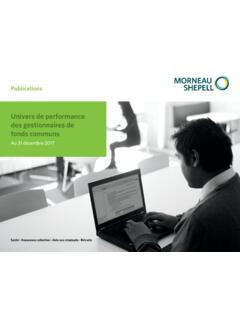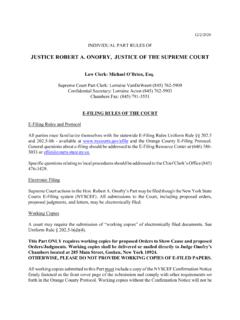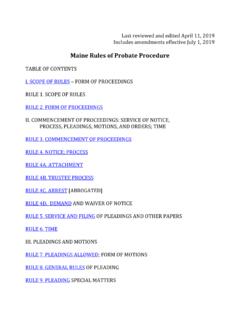Transcription of Best practices in absence & disability management
1 best practices in absence & disability management The complete guide for today's people leaders Contents Chapter 1 About this guide What it is How it can help you Chapter 2 The business case for a strategic approach to absenteeism Defining absenteeism Calculating the true costs (a checklist). Absenteeism drivers Why employers don't track it (but should). The business case for a strategic approach Chapter 3 best practices in absence & disability management 6 Principles for managing absence strategically best practices : attendance management best practices : disability management Chapter 4 Alternatives.
2 Choosing solutions for your organization Key business issues Solution alternatives Outsourcing opportunities & realities Chapter 5 Case studies from Morneau Shepell Media / communications sector Retail sector International consumer packaged goods company Oil & gas sector Chapter 6 The true picture of absenteeism 2014 Research Report best practices in absence and disability management 2. CHAPTER 1. About this guide 1. About this guide Only in the movies does absence make the heart grow fonder. For many HR leaders today, workforce absenteeism is a major challenge often poorly managed because of outdated strategies, systems, policies and processes, all in need of a makeover.
3 As this guide sets out to clarify, workforce absenteeism is: A source of high and constantly rising direct and indirect costs. A serious drag on productivity, however it's defined. A huge factor in undermining your people engagement strategies. What's worse, the sources and complexity of the problem are often hidden. Or put another way: absenteeism is an organizational pathology often misdiagnosed, and, as a result, not effectively managed or mitigated. absence , in short, truly makes the organization grow weaker. What it is This is more than a deep dive into the absence problem and the business case for changing traditional and outdated approaches.
4 It's about best practices for the specific needs of your organization. Our purpose ultimately is to help HR leaders who are struggling to cope with workforce absenteeism and looking for practical, useful advice on addressing the challenge through best practices , not just strategically, but tactically. best practices in absence and disability management 4. How it can help you This guide takes a holistic view of workforce absenteeism as an organizational challenge but also an opportunity for change: It provides objective insight into the problem in all its complexity. It gives a summary of best practices that transform absence from a problem into an opportunity for delivering measurable outcomes.
5 It objectively presents solution alternatives to help you make the best choices for your organization, workforce culture and employees. It concludes with a series of case studies featuring the innovative absence management strategies described in this guide. Today's best -in-class employer understands the direct link between employee health and organizational success. As we see it, every employee matters, every dollar matters, every absence matters. The question is: how much does managing absence strategically matter to you? Our purpose is to help HR leaders who are struggling to cope with workforce absenteeism and looking for practical, useful advice on addressing the challenge through best practices , not just strategically, but tactically.
6 best practices in absence and disability management 5. CHAPTER 2. The business case for a strategic approach to absenteeism 2. The business case for a strategic approach to managing absenteeism It can be argued that traditionally absence has been managed in isolation, as a standalone and reactive administrative function within the benefits group, mostly disconnected from larger organizational priorities or objectives such as cost management , productivity, or employee engagement and retention. But some HR leaders still a minority today have realized that a more strategic, progressive approach is required that involves taking a holistic view of the absence problem and its total impact on their organizations.
7 One important trend shaping new strategies is the notion of adopting an integrated, proactive approach to managing all absence sources, ranging from casual/incidental absence to non-occupational and occupational disability . As well, some organizations are also now linking their strategies to goals that have measurable outcomes, like promoting sustained attendence at work and preventing or minimizing downstream costs. Where are you with your absence management strategies? Are you taking a strategic approach? Are you all the way there? Or just getting started? best practices in absence and disability management 7.
8 Defining absenteeism It appears simple enough: absenteeism in the workforce refers to unplanned absences. Though the costs of these absences may seem relatively easy to establish, the actual loss to an organization is more complex to fully define: Absenteeism costs the total cost of paying absent employees for zero productivity, including incremental costs for replacement labour, overtime, administration, management time, and insurance premiums. And in that definition, you may find surprises you hadn't counted on when it comes to calculating the true or real costs to your organization.
9 Calculating the true costs of absenteeism (a checklist). To understand how our absence definition translates into actual costs there's a little work involved. To help, we've provided a checklist of inputs that take into consideration the direct and indirect costs of absence . As you review the checklist, keep in mind that studies suggest absence accounts for up to 5% of total payroll in the private sector and even more in the public sector. Further, in most industries these costs are growing because of factors like the aging population, rising health and medication costs, and increased diagnoses of mental illness.
10 best practices in absence and disability management 8. Total cost of absence : a checklist Direct costs Indirect costs Salary/payroll costs for absent Replacement costs: recruiting, employees training and integrating new or temporary employees Overtime costs to cover for absent employees management costs: time and effort spent by people leaders Insurance premiums and costs to manage the effects of related to absence absence and replacement Short-term disability (STD) Productivity loss: work not done because of an absence If you're on a salary continuance model, you need to count Client services costs.











